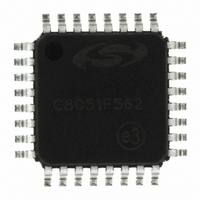C8051F562-IQ Silicon Laboratories Inc, C8051F562-IQ Datasheet - Page 211

C8051F562-IQ
Manufacturer Part Number
C8051F562-IQ
Description
IC 8051 MCU 32K FLASH 32-QFP
Manufacturer
Silicon Laboratories Inc
Series
C8051F56xr
Specifications of C8051F562-IQ
Program Memory Type
FLASH
Program Memory Size
32KB (32K x 8)
Package / Case
32-QFP
Core Processor
8051
Core Size
8-Bit
Speed
50MHz
Connectivity
SMBus (2-Wire/I²C), LIN, SPI, UART/USART
Peripherals
POR, PWM, Temp Sensor, WDT
Number Of I /o
25
Ram Size
2.25K x 8
Voltage - Supply (vcc/vdd)
1.8 V ~ 5.25 V
Data Converters
A/D 25x12b
Oscillator Type
Internal
Operating Temperature
-40°C ~ 125°C
Processor Series
C8051F5x
Core
8051
Data Bus Width
8 bit
Data Ram Size
2304 B
Maximum Clock Frequency
50 MHz
Number Of Programmable I/os
25
Operating Supply Voltage
1.8 V to 5.25 V
Maximum Operating Temperature
+ 125 C
Mounting Style
SMD/SMT
3rd Party Development Tools
PK51, CA51, A51, ULINK2
Development Tools By Supplier
C8051F560DK
Minimum Operating Temperature
- 40 C
Lead Free Status / RoHS Status
Lead free / RoHS Compliant
For Use With
336-1691 - KIT DEVELOPMENT FOR C8051F560
Eeprom Size
-
Lead Free Status / Rohs Status
Lead free / RoHS Compliant
Other names
336-1698
Available stocks
Company
Part Number
Manufacturer
Quantity
Price
Company:
Part Number:
C8051F562-IQ
Manufacturer:
Silicon Laboratories Inc
Quantity:
10 000
Company:
Part Number:
C8051F562-IQR
Manufacturer:
Silicon Laboratories Inc
Quantity:
10 000
- Current page: 211 of 302
- Download datasheet (3Mb)
The length of the 4 bit segments must be adjusted so that their sum is as close as possible to the desired
bit time. Since each segment must be an integer multiple of the time quantum (t
bit time is 24 tq (1000.008 ns), yielding a bit rate of 0.999992 Mbit/sec. The Sync_Seg is a constant 1 tq.
The Prop_Seg must be greater than or equal to the propagation delay of 400 ns and so the choice is 10 tq
(416.67 ns).
The remaining time quanta (13 tq) in the bit time are divided between Phase_Seg1 and Phase_Seg2 as
shown in. Based on this equation, Phase_Seg1 = 6 tq and Phase_Seg2 = 7 tq.
The Synchronization Jump Width (SJW) timing parameter is defined by. It is used for determining the value
written to the Bit Timing Register and for determining the required oscillator tolerance. Since we are using
a quartz crystal as the system clock source, an oscillator tolerance calculation is not needed.
The value written to the Bit Timing Register can be calculated using Equation 18.3. The BRP Extension
register is left at its reset value of 0x0000.
Bit Timing Register = (TSEG2 x 0x1000) + (TSEG1 x 0x0100) + (SJWp x 0x0040) + BRPE = 0x6FC0
1. If Phase_Seg1 + Phase_Seg2 is even, then Phase_Seg2 = Phase_Seg1. If the sum is odd, Phase_Seg2 =
2. Phase_Seg2 should be at least 2
Phase_Seg1 + 1.
1t
Phase_Seg1 + Phase_Seg2 = Bit_Time – (Synch_Seg + Prop_Seg)
Equation 21.3. Calculating the Bit Timing Register Value
q
Bit Timing Register = (TSEG2 x 0x1000) + (TSEG1 x 0x0100)
Equation 21.2. Synchronization Jump Width (SJW)
Sync_Seg
TSEG1 = Prop_Seg + Phase_Seg1 - 1 = 10 + 6 – 1 = 15
Equation 21.1. Assigning the Phase Segments
BRPE = BRP – 1 = BRP Extension Register = 0x0000
1t
Prop_Seg
Figure 21.3. Four segments of a CAN Bit
1 to 8 t
q
SJWp = SJW – 1 = minimum (4, 6) – 1 = 3
SJW = minimum (4, Phase_Seg1)
t
TSEG2 = Phase_Seg2 – 1 = 6
q
q
CAN Bit Time (4 to 25 t
.
Rev. 1.1
Phase_Seg1
1 to 8 t
q
C8051F55x/56x/57x
q
)
Phase_Seg2
Sample Point
1 to 8 t
q
), the closest achievable
q
211
Related parts for C8051F562-IQ
Image
Part Number
Description
Manufacturer
Datasheet
Request
R
Part Number:
Description:
SMD/C°/SINGLE-ENDED OUTPUT SILICON OSCILLATOR
Manufacturer:
Silicon Laboratories Inc
Part Number:
Description:
Manufacturer:
Silicon Laboratories Inc
Datasheet:
Part Number:
Description:
N/A N/A/SI4010 AES KEYFOB DEMO WITH LCD RX
Manufacturer:
Silicon Laboratories Inc
Datasheet:
Part Number:
Description:
N/A N/A/SI4010 SIMPLIFIED KEY FOB DEMO WITH LED RX
Manufacturer:
Silicon Laboratories Inc
Datasheet:
Part Number:
Description:
N/A/-40 TO 85 OC/EZLINK MODULE; F930/4432 HIGH BAND (REV E/B1)
Manufacturer:
Silicon Laboratories Inc
Part Number:
Description:
EZLink Module; F930/4432 Low Band (rev e/B1)
Manufacturer:
Silicon Laboratories Inc
Part Number:
Description:
I°/4460 10 DBM RADIO TEST CARD 434 MHZ
Manufacturer:
Silicon Laboratories Inc
Part Number:
Description:
I°/4461 14 DBM RADIO TEST CARD 868 MHZ
Manufacturer:
Silicon Laboratories Inc
Part Number:
Description:
I°/4463 20 DBM RFSWITCH RADIO TEST CARD 460 MHZ
Manufacturer:
Silicon Laboratories Inc
Part Number:
Description:
I°/4463 20 DBM RADIO TEST CARD 868 MHZ
Manufacturer:
Silicon Laboratories Inc
Part Number:
Description:
I°/4463 27 DBM RADIO TEST CARD 868 MHZ
Manufacturer:
Silicon Laboratories Inc
Part Number:
Description:
I°/4463 SKYWORKS 30 DBM RADIO TEST CARD 915 MHZ
Manufacturer:
Silicon Laboratories Inc
Part Number:
Description:
N/A N/A/-40 TO 85 OC/4463 RFMD 30 DBM RADIO TEST CARD 915 MHZ
Manufacturer:
Silicon Laboratories Inc
Part Number:
Description:
I°/4463 20 DBM RADIO TEST CARD 169 MHZ
Manufacturer:
Silicon Laboratories Inc











